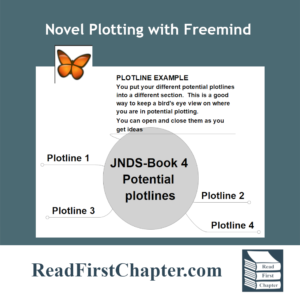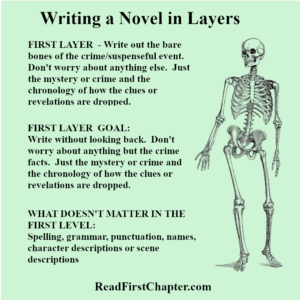WHERE WE LEFT OFF:
 In the first installment of the Peek Behind the Novel Series, I wrote about working four different plotlines before choosing one. By working on four of them, it helps me ‘improve’ on some storylines and when I have four to choose from, I am able to go into the project knowing that I have chosen the best one. It’s a technique that I use to build my author confidence.
In the first installment of the Peek Behind the Novel Series, I wrote about working four different plotlines before choosing one. By working on four of them, it helps me ‘improve’ on some storylines and when I have four to choose from, I am able to go into the project knowing that I have chosen the best one. It’s a technique that I use to build my author confidence.
THE FIRST LAYER OF WRITING A NOVEL – THE CHRONOLOGY OF A CRIME
 In the first layer of writing, I focus only on the crime or mystery. I make a list of the chronology of the crime. How it happens, who it happens to, how the detectives are assigned to the case. I focus only on the crime. I don’t think of subplots, or dialogue or even the outcome. Only on the crime itself, almost like a Forensic Files show.
In the first layer of writing, I focus only on the crime or mystery. I make a list of the chronology of the crime. How it happens, who it happens to, how the detectives are assigned to the case. I focus only on the crime. I don’t think of subplots, or dialogue or even the outcome. Only on the crime itself, almost like a Forensic Files show.
This layer of writing is only a chronological list of the crime or mystery and how it plays out. Mine looks like a list with small paragraphs and one line clues. It could even look like a printout from Google maps!
DIVIDE AND CONQUER:
Once I have the chronology of the crime, I begin to break the chronology into four parts. Nothing fancy; just Parts 1, 2, 3 and 4. By breaking the crime up into four sections, I’m preparing it to be plugged into the ‘four-act play’ format. I never took to the three-act play because the center section is too unstructured and it’s twice as long as the other sections. It’s called one part, but it’s really two parts in one. It was too asymmetrical for me. So rather than using a three act structure, I break Act 2 into two separate parts.
PART 1 – Introduction to the Detectives and Normal Life:
In Part 1, the detectives hear about the crime or mystery and are somehow assigned to it. That assignment is different in each case. I start in their normal working lives and have them pulled into the crime.
This part also entails the scene of the crime and whatever clues may or may not be present. One or maybe two suspects will arise at the scene or shortly thereafter.
Part 1 – The Inciting Incident:
In a police procedural, being assigned to the case is the inciting incident. They are called into this crime investigation whether they want to be or not. Part 1 will end with the inciting incident. They have seen the scene of the crime and have gathered their first clue or clues. They are now off on a quest to solve the crime.
Part 2 – The Investigation Begins:
 The Jack Nolan Detective Series is about two detectives, Jack and Fiona, who have personal lives that are also in flux. Part 2 introduces the subplots about the detectives and the early investigations they go off on.
The Jack Nolan Detective Series is about two detectives, Jack and Fiona, who have personal lives that are also in flux. Part 2 introduces the subplots about the detectives and the early investigations they go off on.
The facts as well as clues begin to trickle into the storyline so that the reader can start trying to10 guess who committed the mystery or crime.
The end of Part 2 is the midpoint of the story, so I try to have a twist or a revelation that changes the direction of the investigation in some way.
Part 3 – The Truth Begins to Seep Out:
Early in Part 3, the last suspect will appear and the detectives will be trying to figure out who has the greater motivation. Or which of the suspects had the time and opportunity to commit the crime. Also in part 3, the masks on the suspects begin to fall and their secrets are exposed and a couple even are caught in a lie or two.
The end of Part 3 is the equivalent of a Dark Night of the Soul. This is a place where maybe the detectives can’t figure out who did it, or they know but can’t find proof, or there is a chance the bag guy or girl will get away with it for one reason or another. It is a low point. This could also coincide with a low point in one of the detective’s personal lives.
Part 3 ends on this darker moment. I want the reader to be worried that the detectives won’t solve it in time, or the bad guy will get away with something.
PART 4 – The Big Reveal
The beginning of Part 4 is the big reveal. There is one clue or one revelation that confirms the guilt of whatever the real bad guy is. This sets up a situation where the bad guy is going to get away, or the detectives have to trap him or her — however you choose to ‘solve’ the case.
The second part of Part 4 is where I as the author, very quickly, wrap up the whole crime. I like to do this in case my readers are reading with one eye open. People are busy today and often they may miss something. So I like to spell it out very quickly — because I don’t want to bore the readers who were paying attention — how the crime occurred and how the evidence was there all along.
Next you wrap up the subplots and resolve and reveal anything that is hanging in the air, like the red herring, or how other suspects couldn’t have done it. You also want to wrap up the subplots on a satisfying note.
IF YOU ARE WRITING A SERIES:
My series are four or more books, so the personal lives are written a bit like a soap opera. The characters do have a full character arc in each novel. They learn something in that book that I reflect on in the end, but I also drop a clue at the end of the mystery/crime that the story will continue in the next book.
I DON’T WANT TO GET AHEAD OF MYSELF:
I’ve just given you a bird’s eye view of how the book will proceed when marrying all four parts of it together. But this first layer is only the chronology of the crime.
I also end this layer with a section I call “How it will end”. It never ends the way I think it will, but committing to an end this early at least gives me a direction and a destination. It’s easy enough to change the chronology when the story takes a natural turn or changes within the creative process.
